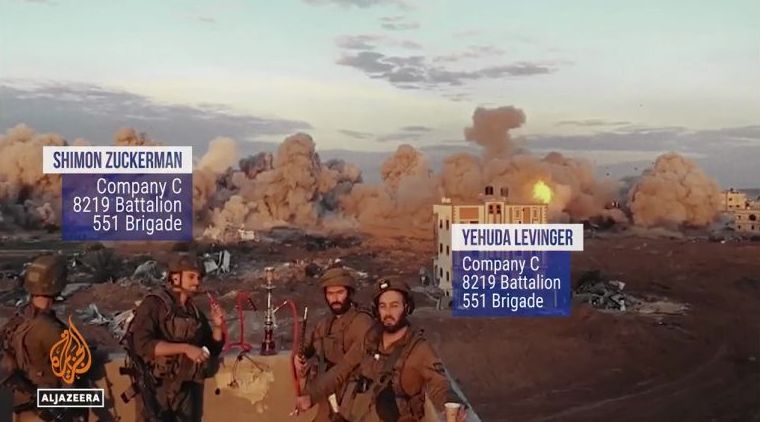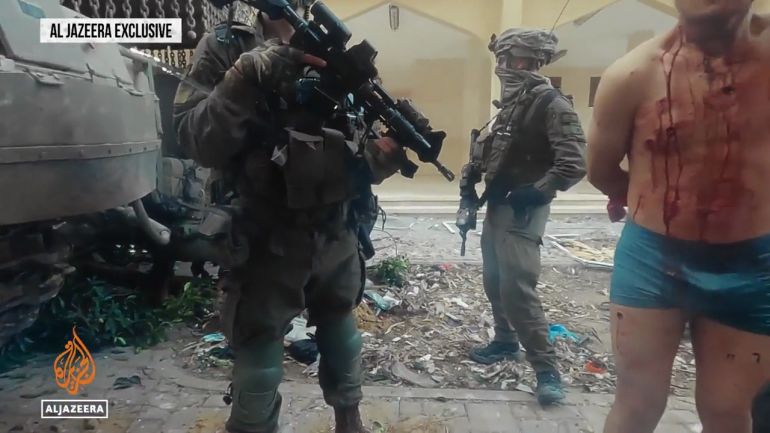October 6, 2024, PM Edition
What Has Been Learned in the Past Year of the Al-Aqsa Flood
New Film Brings Together Reams of Documentary Evidence of Zionist War Crimes
• New Film Brings Together Reams of Documentary Evidence
of Zionist
War Crimes
• About Al Jazeera's Film Gaza
What Has Been Learned in the Past Year of the Al-Aqsa Flood
New Film Brings Together Reams of Documentary Evidence of Zionist War Crimes
Al Jazeera's Investigative Unit (I-Unit) brought together thousands of videos and photos posted to social media by Israeli soldiers. With filmmaker Richard Sanders, Al Jazeera has made a film from this "flood of social media posts from Israeli soldiers" boasting about specific actions they have carried out in their treatment of the Palestinian people in the past year. The film is a contribution to what has been learned in the past year of the Al-Aqsa flood.
These photos have been available daily on social media since the beginning of Operation Al-Aqsa Flood when the Palestinian Resistance attacked the military posts north of Gaza responsible for enforcing the Israeli occupation of Gaza and committing untold crimes against the Palestinian people. It was a legitimate act of resistance against an unlawful occupation which according to the International Court of Justice (ICJ) must be ended.
The photos provide horrifying evidence of actions of Israeli Zionist soldiers about which the U.S., UK, Canada and other countries are fully aware but refuse to acknowledge, let alone condemn. This tells us a great deal about their self-serving politicized definitions of human rights, war crimes, rule of law, democracy, the values they uphold, as well as the impunity with which they are silencing and criminalizing those at home and abroad they have labeled "anti-Semites," "terrorists," and dangers to national security.
Despite these countries' use of their positions of power and privilege, they cannot escape the fact that these photos provide evidence of the crimes they and their legacy media, spokespersons, and alleged experts are permitting, with the endless repetition of their narrative justifying their support for Israel by accusing the resistance forces of violating human rights. This evidence will be used to prove they are complicit in the commission of the horrific crimes and the crime of genocide, as established by the International Court of Justice (ICJ).
The footage is too horrifying for many viewers but nonetheless constitutes irrefutable evidence which holds the government of Canada and official circles which comprise the party cartel which continues to support the criminal actions of the Israeli occupiers to account. Pleading ignorance will not do. We have witnessed these crimes being committed day after day after day for a full year. Canada must stop supporting Israel and it must stop NOW.
About Al Jazeera's Film Gaza
The feature-length film Gaza, produced by Al Jazeera's Investigative Unit (I-Unit), exposes Israeli war crimes in the Gaza Strip through the medium of photos and videos posted online by Israeli soldiers themselves during their year-long genocide.
"When they entered Gaza on October 27, after three weeks of aerial bombardment following Hamas' October 7 attack on Israel, Israeli troops took their iPhones with them," an article by filmmaker Richard Sanders and Al Jazeera says.
"In the year since, Israeli soldiers have posted thousands of videos and photos on Instagram, Facebook, TikTok and YouTube.
"These videos and photos form the foundation of the I-Unit's new film, which investigates Israeli war crimes primarily through the medium of the evidence Israeli soldiers themselves have provided."
Al Jazeera's I-Unit decided to investigate these posts. Al Jazeera writes that the I-Unit "expected to have to dedicate considerable resources to geolocation -- the use of satellite maps and other sources to identify specific locations -- and to the use of facial recognition software to scan the internet to identify the soldiers featured in the photos and videos. What it found, however, was that, for the most part, soldiers posted material in their own names on publicly accessible platforms and often gave details of when and where the incidents depicted took place.
"The I-Unit began collecting these videos and photos, compiling a database of more than 2,500 social media accounts."
It showed the footage to a range of military and human rights experts, including international law expert Rodney Dixon, Charlie Herbert, a retired major-general in the British Army, and Bill Van Esveld, the associate director for the Middle East and North Africa at Human Rights Watch.
Al Jazeera says that "It also employed teams on the ground to film the testimony of witnesses and made use of Israeli drone footage collected by Al Jazeera Arabic.
Al Jazeera reports that most of the photos and videos "fell into one of three categories: wanton destruction, the mistreatment of detainees and the use of human shields." The conclusion drawn by the experts consulted is that "several of the incidents documented merited investigation by international investigators." The report says "All three may be violations of international humanitarian law (IHL) and war crimes under the Rome Statute of the International Criminal Court."
Wanton destruction
Richard Sanders and Al Jazeera write:
"The videos frequently show soldiers smashing up and destroying property and possessions. Others show houses being set alight. The most commonly recurring feature was the detonation of buildings."
"The fact that they've been able to rig these buildings up with explosives shows very clearly that there's no current threat from those buildings," Herbert told Al Jazeera.
"There's no justification for destroying a structure if the enemy isn't in it," said Van Esveld. "You can't go around wantonly, unnecessarily destroying civilian property It's banned," he added. "And if you do enough of it, it's a war crime."
International Humanitarian Law (IHL) says the following about the destruction of property:
Article 8(2)(a)(iv) of the Rome Statute prohibits "extensive destruction and appropriation of property, not justified by military necessity and carried out unlawfully and wantonly".
 Israeli soldiers have posted many videos on social media showing them destroying
Israeli soldiers have posted many videos on social media showing them destroying
buildings in Gaza. (Al
Jazeera)
Mistreatment of detainees
Al Jazeera reports: "Some of the videos show large numbers of detainees stripped to their underwear, being held in stress positions and mocked for having soiled themselves. One shows naked and near-naked detainees, bound and blindfolded, being kicked and dragged around on the floor.
"In one video, a French-Israeli soldier films a detainee being pulled from the back of a truck and says: 'Look, I'm going to show you his back. You're going to laugh at this. He was tortured.'"
Soldiers' videos are complemented by witness testimony gathered by the I-Unit's team in Gaza.
IHL says the following about the mistreatment of detainees:
Article 8 (2)(a)(ii) of the Rome Statute prohibits "torture or inhuman treatment, including biological experiments"; while Article 8 (2)(b)(xxi) prohibits "committing outrages upon personal dignity, in particular humiliating and degrading treatment."
Human Shields
Al Jazeera's I-Unit obtained video of Palestinians being used as human shields. It interviewed six individuals who testified to being used as human shields by Israeli troops.
Footage gathered by Al Jazeera Arabic shows a detainee being forced to inspect empty buildings while being monitored by a drone. Separate footage shows bloodied detainees being fitted with cameras so they can enter buildings troops have not yet secured.
A photo taken by an Israeli soldier in Gaza City in November – and posted online — shows two detainees walking in front of a tank with a soldier behind them. In an interview, one of the men later described how they were coerced and used as human shields.
At the Nasser Hospital in Khan Younis in February a young man was forced to act as a messenger by the Israelis, ordering displaced people to evacuate the building. The man was then shot dead by a sniper in front of his mother.
Using people to perform military tasks is "in many ways the definition of using persons as a human shield," Dixon explained.
This is what IHL has to say about using civilians as human shields:
Article 8 (2)(b)(xxiii) of the Rome Statute prohibits "utilizing the presence of a civilian or other protected person to render certain points, areas or military forces immune from military operations."
To watch the film Gaza, click here
(To access articles individually click on the black headline.)
Website: www.cpcml.ca • Email: editor@cpcml.ca





